Hola mis amigos: A VUELO DE UN QUINDE EL BLOG., hemos recibido información de la Fundación Nacional de Ciencias de Los Estados Unidos, sobre el estudio que ellos han efectuado; sobre el valor ecológico que cumplen los lobos recién implantados en El Parque Nacional de Yellowstone
More information.......http://search.usa.gov/search?affiliate=nsf&query=Wolves&x=0&y=0
http://www.nsf.gov/news/special_reports/science_nation/wolfecology.jsp?WT.mc_id=USNSF_51
Study of predator-prey relationships in Yellowstone could contribute to predator conservation and management worldwide
Long loathed as a threat and nuisance, the wolf population in Yellowstone National Park was essentially wiped out by the mid 1920s. That changed in 1995, when the National Park Service reintroduced wolves there, with the goal of restoring a natural predator/prey dynamic to the landscape.
So, 20 years later, how has the park's ecosystem responded to the return of the wolves? That's just what Utah State University wildlife ecologist Dan MacNulty and his team want to find out.
With support from the National Science Foundation (NSF), and working in partnership with the National Park Service, MacNulty and his team are hot on the trail of the wolves' primary prey--elk. The team is following individually marked wolves and elk to determine how and why wolf-elk interactions fluctuate over time, the effects of these fluctuations on wolf traits and vital rates, and how wolves, grizzly bears and cougars interact to influence elk mortality rates. Fuller understanding of what's happening here could translate to better predator management decisions all over the globe.
The research in this episode was supported by NSF award #1245373, Collaborative Research: LTREB Renewal: Yellowstone wolves: their ecology and community consequences. LTREB is NSF's Long Term Research in Environmental Biology program.
Wolves and Yellowstone. In the public mind, and in nature, the two are inextricably linked. Now, it turns out, they aren't alone on the ecological dance floor. Elk and willows play a critical role in wolves' success in the Yellowstone National Park ecosystem, willows serving as browse for elk--and elk as food for wolves. But there's another species involved, one that's instrumental to these well-choreographed steps: the beaver. Find out more in this discovery.
Credit: NPS
Credit: NPS
Once common in much of North America, Europe and parts of Asia, gray wolves now roam a comparatively tiny range. Worldwide, habitat loss and the effects of global warming threaten the long-term future for these icons of the wilderness. In the short-term, wolves must find enough ungulate prey like elk to weather the winter. The bigger the wolf, the better its ability to hunt and take down such prey. Or so it would seem. To find out whether larger body size in fact leads to better predator performance, ecologist Dan MacNulty of Utah State University along with other scientists studied whether wolves' size-related ability to handle prey might come at the expense of successfully pursuing that prey. Find out more in this discovery.
Credit: NPS/Dan Stahler
Credit: NPS/Dan Stahler
The Division of Environmental Biology (DEB) of the Biological Sciences Directorate supports fundamental research on populations, species, communities and ecosystems. Scientific emphases range across many evolutionary and ecological patterns and processes at all spatial and temporal scales.
Dogs and wolves evolved from a common ancestor between 9,000 and 34,000 years ago, before humans transitioned to agricultural societies, according to an analysis of modern dog and wolf genomes from areas of the world thought to be centers of dog domestication.
Discovery
Yellowstone Ecosystem Needs Wolves and Willows, Elk and...Beavers?

Yellowstone Ecosystem Needs Wolves and Willows, Elk and...Beavers?
Scientists plot crucial links among Yellowstone plant and animal species
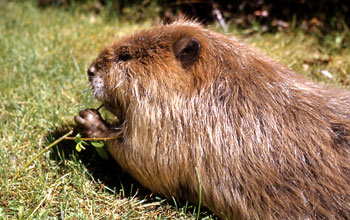 Credit and Larger Version |
February 7, 2013
This article is the fifth in a series on NSF's Long Term Research in Environmental Biology (LTREB) awards. Visit parts one, two, three, four, six, seven and eight.
Wolves and Yellowstone. In the public mind, and in nature, the two are inextricably linked.
Now, it turns out, they aren't alone on the ecological dance floor.
Elk and willows play a critical role in wolves' success in the Yellowstone National Park ecosystem, willows serving as browse for elk--and elk as food for wolves.
But there's another species involved, one that's instrumental to these well-choreographed steps: the beaver.
"Beavers are the missing piece in this ecosystem," says ecologist Tom Hobbs of Colorado State University (CSU) in Fort Collins.
No wolves, no beavers
The loss of wolves caused far-reaching changes in the Yellowstone ecosystem: more elk and fewer willows. With no willows to slow stream flow, creeks flowed faster and faster. Beavers prefer slow-moving waters, so they disappeared with the willows.
"Putting wolves back isn't enough to reverse the extensive changes caused by their long absence," says Hobbs, who, along with other scientists discovered in a decade-long research project.
The ecologists published results of their study this week in the journal Proceedings of the Royal Society B. In addition to Hobbs, co-authors are Kristin Marshall, formerly of CSU and now of the National Oceanic and Atmospheric Administration, and David Cooper of CSU. Marshall is the paper's lead author.
"This research illustrates the value of long-term ecological experiments to understanding how species interactions cascade through food webs to determine ecosystem resilience," says Alan Tessier, program director in the National Science Foundation's (NSF) Division of Environmental Biology, which funded the research.
"The results have immediate practical applications in restoring and protecting ecosystems such as that of Yellowstone."
Wolves aren't enough
Scientists had thought that the return of the wolf, leading to a cutback on elk numbers and willow browsing, was central to restoring the Yellowstone ecosystem. "But Yellowstone also needs beavers," says Hobbs.
That's why bringing back wolves didn't work to quickly restore the ecosystem, the researchers believe.
Wolves hunted elk and brought down numbers of these ungulates. But removing elk browsing wasn't enough for the willows. They needed the sluggish streams created by beavers. But the beavers were gone.
Streams: the missing link
Once, beavers had been abundant anywhere streams flowed through Yellowstone. And that was almost everywhere.
In the past, dams made by beavers were ubiquitous features of Yellowstone's stream network. A third of mainstream reaches show evidence of sediment deposition as a result of beaver dams, a process that's happened for millennia. That sediment offered willows a place to take root.
In the spring of 1921, scientist Edward Warren of the Roosevelt Wild Life Forest Experiment Station in Syracuse, N.Y., conducted a study of beavers in Yellowstone. Warren found beavers and their ponds scattered throughout the park.
Near the Elk Creek Bench Colony, for example, Warren spotted "a group of beaver ponds which present interesting features," he stated in a report published in the 1920s.
"The water supply is a small brook originating from springs in a boggy tract of several acres. The brook flows through a flat depression in a ridge, and it is in the swampy, springy ground just below the woods that most of the ponds are located."
It's a rare if not non-existent sight in Yellowstone today, especially on the park's northern range where Hobbs' team conducted its research.
"Excessive browsing of willows (by elk after wolves were gone) was implicated in the disappearance of beavers from streams during the 20th century," Marshall, Hobbs and Cooper write in their paper. "The loss of beaver ponds from the stream network...compressed the area of bare, moist substrate needed for willow establishment."
Yellowstone ecosystem questions: answered by beavers?
Restoring an ecologically complete ecosystem in Yellowstone requires the return of willows--and with them, beavers.
There's a clear threshold for ecosystem recovery. Willow stands must be more than 6 feet tall, the scientists found. That height is important, says Marshall. Then willows are beyond the reach of browsing elk, and can serve as seed sources for new young willows.
Once willows have returned, beavers will gnaw down a certain number of them to build dams. The dams will further slow stream flow, allowing yet more willows to grow.
The results offer new insights on the role of wolf-driven trophic cascades in the Yellowstone ecosystem, says Hobbs.
Trophic cascades like that in Yellowstone occur when predators--or the lack thereof--in an ecosystem change the abundance or alter traits of their prey, in turn affecting the next lower trophic level.
"The reintroduction of wolves to Yellowstone has contributed to improvements in the park's ecology, but clearly that ecology is a complicated one," says Marshall. "The take-home message is that we have to be careful not to remove predators in the first place."
--
|
Cheryl Dybas, NSF (703) 292-7734 cdybas@nsf.gov
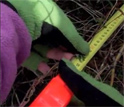 View a video of stream, willow, and beaver research in Yellowstone. Credit and Larger Version 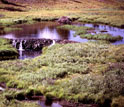 A long-ago beaver dam, a rare sight today, along a stream in Yellowstone National Park. Credit and Larger Version 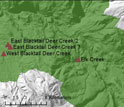 Locations of the project's experimental sites on Yellowstone's northern range. Credit and Larger Version 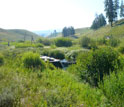 Summertime at the team's upstream research site along East Blacktail Deer Creek. Credit and Larger Version 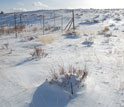 Snow covers East Blacktail Deer Creek in winter. Still, most browsing occurs then. Credit and Larger Version 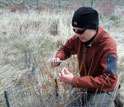 Using calipers, scientist Kristin Marshall measures the diameters of browsed willow stems. Credit and Larger Versión |
The National Science Foundation
Guillermo Gonzalo Sánchez Achutegui
Inscríbete en el Foro del blog y participa : A Vuelo De Un Quinde - El Foro!



No hay comentarios:
Publicar un comentario